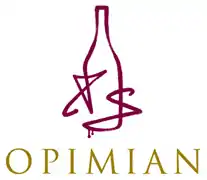Opimian Society
Opimian is a Canadian nonprofit wine purchasing cooperative based in Montreal, Quebec. Established in 1973, the wine club was created by a quartet of British-born Canadians who felt that the selection of wines available in Canada was a poor representation of the quality of wines available worldwide.[1][2]

Marketed as “Canada’s largest wine club,” Opimian has grown since its inception, now acting as Canada's largest wine buying group with 20,000 members (and growing).[3][4]
Overview
The name “Opimian” derives from the Roman consul, Lucius Opimius, who discovered the famous 121 BC vintage and gave it only to discriminating wine connoisseurs.[5] Like Lucius Opimius, Opimian sources premium wines on behalf of their members. A purchasing co-operative, they access the diversity of the world's wines within the constraints of the government monopolies and controls.[2]
In the Community
Opimian is divided into 27 regions, called Opimian Chapters, across Canada, each with a volunteer representative called an Area Representative. The volunteers organize local tastings and create a “social dimension to membership.”[5]
Opimian's mandate is to provide wine education. In March 2008, the board of directors voted to make a donation to the Niagara College Foundation. The donation was made in two parts – a $20,000 Scholarship, titled “The Opimian Society Scholarship” and a $30,000 donation toward the building of the Wine Education Center.[6] The Opimian Society Scholarship was received by one person in 2009 and two people in 2010 and 2011.
Impact on Canada
Liquor boards and consumers have used Opimian as a de facto test market for new brands. Spain's Freixenet, Australia's Rosemount Estate and Scotland's The Macallan all started out as Opimian selections before becoming mainstays in the Canadian market. Opimian is a quietly influential national wine-buying club that has aided in sophisticating the adult-drink trade in Canada.[1]
Wine
Ten times a year, members receive catalogues of the wines offered by Opimian. The catalogues are referred to as “Cellar Offerings” and feature different regions.[7]
Cellar Offering
This is marketed as an educational guide that will provide members with information on wine regions, grapes, vineyards and winemakers; the vehicle for their tasting notes, food pairing tips and cellaring advice.[7] Graphic charts instruct the reader on proper serving temperatures and storage life for the wine.[2] All Opimian wines are sourced by a Master of Wine, Opimian's wine consultant. The Master of Wine is responsible for selecting each of the wines offered, sourcing new suppliers,[2] providing tasting notes, Maturity & Drinkability ratings and answering any wine related questions from members. The wines offered are not available anywhere else in Canada,[3] thus one does not see mainstream, well-known or documented brands. Foreknowledge of purchases is further constrained by a lack of independent ratings and reviews for the wines.[8]
Working with the Provincial Liquor boards
Opimian has always co-operated with local alcohol monopolies.[5] All Opimian wines are officially imported and cleared by the respective liquor boards in each province, ensuring that all taxes and liquor mark ups are included in the pricing.[8] Members order wine, which is then purchased on their behalf through the liquor boards and distributed through the Liquor Board stores and warehouses.[4]
Membership
Members pay an annual fee of $69 + applicable taxes, depending on their province.[3] Benefits include;
Growth and Statistics
2010
2006
- 15,600 members spend an average of $1,700 per year
- 2,500 members are in Alberta[11]
2003–2006
- Membership grew 10% after a slowdown in the 1990s[1]
See also
References
- Crosariol, Beppi (29 July 2007), It's not all turned up noses at this wine club, The Globe and Mail, retrieved 2011-05-19
- Hopper, Tristin (17 September 2008), Talkin' wine with Pierre, Yukon News, retrieved 2011-05-19
- Ring, Treve (8 March 2011), Wine Buying Clubs, Eat Magazine, retrieved 2011-05-19
- Porter, Warren (17 June 2010), Gone Clubbing, Good Food Revolution, retrieved 2011-05-19
- Stimmell, Gord (4 October 2008), LCBO just a drop in the bucket in the world of wine, Toronto Star, p. Living section, L16
- Niagara College student wins first Opimian Society Scholarship, Niagara College News, April 7, 2009, retrieved 2011-05-19
- About Us, Opimian, retrieved 2011-05-19
- Lawrason, David (5 June 2006), Tio Pepe and Opimian Society, Toronto Life, retrieved 2011-05-19
- Aspler, Tony (3 March 2008), Who is Who in Canada, Wine Business International, retrieved 2011-05-19
- Wine Clubs, Highlander Wine & Spirits, retrieved 2011-05-19
- Join the Club, The Calgary Herald, 8 October 2006, retrieved 2011-05-19
- About Tidings Magazine, Tidings Magazine, retrieved 2011-05-19